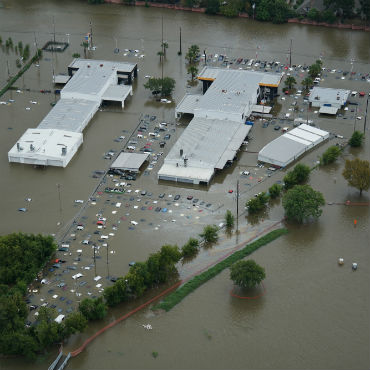Drones take center stage in Harvey recovery

Hurricane Harvey represents an inflection point for the use of unmanned aerial systems in disaster recovery operations, according to the FAA administrator.

An aerial view of flooding during Hurricane Harvey. (Photo credit: DIIMSA Researcher / Shutterstock.com)
Unmanned aerial systems exacerbated some rescue problems in the Houston area in the wake of Hurricane Harvey, but they've also helped speed recovery there, according to the Federal Aviation Administration chief Michael Huerta.
"I don't think it's an exaggeration to say that the hurricane response will be looked back upon as a landmark in the evolution of drone usage in this country," said Huerta in remarks at the InterDrone Conference in Las Vegas.
As storm surge inundated homes, businesses, roads and industrial sites in Houston and eastern Texas, a variety of organizations sought FAA authorization to fly drones in areas protected by temporary flight restrictions, Huerta said at the Sept. 6 conference.
While the storm churned through Houston, the FAA had warned private drone operators in the area surveying the aftermath that they could face steep fines if their unauthorized aircraft got in the way of manned rescue aircraft.
On Sept. 7, as Hurricane Irma approached Florida, the agency issued similar warnings to drone operators about steep fines and the dangers of interfering with emergency operations.
After Harvey hit Texas, Huerta said the FAA began trying to move drone authorizations through its approval cycles quickly to help law enforcement and critical infrastructure providers assess the aftermath.
"We recognized that we needed to move fast -- faster than we have ever moved before," said Huerta of the FAA's response to the Texas storm.
"So we basically made the decision that anyone with a legitimate reason to fly an unmanned aircraft would be able to do so. In most cases, we were able to approve individual operations within minutes of receiving a request," he said.
After Hurricane Harvey exited the Texas Gulf Coast, Huerta said his agency issued more than 70 authorizations covering a broad range of recovery activities by local, state and federal agencies, including fire departments, railroad companies and emergency management officials who used the aircraft to look at buildings, bridges and roadways for critical damage. Cell tower companies also launched drones to assess towers and ground equipment, and insurance companies put them in the air to look at damage to neighborhoods, he said.
The use of quick, agile and easily-launched drones, Huerta said, allowed safer and more efficient operations than if conventional manned aircraft had to operate out of closed or damaged airports with limited fuel supplies.
The date of Harvey's trip across the Texas coast ironically coincided with the first anniversary on Aug. 29 of the FAA's implementation of its small unmanned aircraft rule, Part 107, which requires drone pilots have operating certification and sets rules for drones weighing less than 55 pounds and operating under 400 feet.
In the past year, Huerta said, more than 79,000 commercial aircraft have been registered and more than 59,000 remote pilot certificates have been issued.


